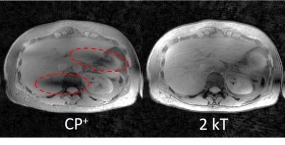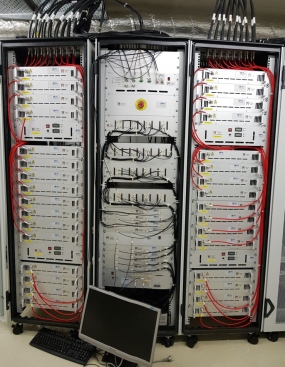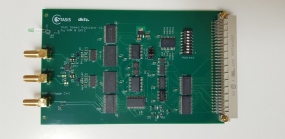Multi-Channel Transmit Systems
Since the beginning of Magnetic Resonance Imaging (MRI) there has been a constant drive to higher magnetic field strengths. The reason for this is the enhanced signal-to-noise-ratio (SNR) and improved contrast the increase in main magnetic field strengths provides. While 1.5T and 3T have become clinical standard, higher fields have emerged in scientific application with 7T having recently found its way into clinical practice.

MR images illustrating signal dropouts in a shim (CP+) compared to an excitation with 2 kT-Points. While the shim shows signal dropouts (marked in red) the kT-Points excitation shows a homogenous excitation of the liver.
© dkfz.de
While a rise in SNR and enhanced contrast can potentially increase the diagnostic value of the images acquired with higher field strengths, higher field strengths also bring challenges. The radio frequency (RF) fields used to excite the spins have to have the same frequency as the spins. This is called the Larmor frequency and it is proportional to the main magnetic field strength. Since the wavelength of RF waves is anti-proportional to frequency, the waves become much shorter at higher main magnetic field strengths. For example at 7T the wavelength in tissue at the Larmor frequency is about 11-13cm which is smaller than the diameter of even a human head. This leads to wave effects with brighter and darker areas with in the field of view, which severely affect image quality. To cope with this, multichannel approaches can be used where multi-channel transmit arrays are driven by the multiple amplifiers of a multi-channel RF system. With such a system, the effects of the reduced wavelength on the image quality can not only be reduced, but also more sophisticated transmit techniques like selective excitation can be enhanced. Furthermore, the increased degrees of freedom provided by multichannel transmit systems allow more control over local specific absorption rate (SAR), allowing for shorter repetition times and higher flip angles.

This photo shows part of the electronics of the 32 channel transmit system. Visible are the amplifiers, modulators, logic controllers and the distortion correction.
© dkfz.de
Our group has developed and implemented a 32 channel transmit system as an add-on for the 7T MRI system of the DKFZ [1].
The system consists of 32 IQ-modulators, 32 RF 2 kW peak power amplifiers with pre-distortion, a power supervision for patient safety, and integrated RF body array and peripheral devices to control correct timings.
The high channel count and high RF power of the system allow to acquire images with a large field of view tailored excitation to get closer to the full potential of 7T MRI.
Currently we are working on:
- Modulators with higher resolution and sampling rate
- More efficient amplifiers for high duty-cycle sequences
- A more modular design to allow for even higher channel counts

Prototype of a new high speed, high resolution RF modulator.
© dkfz.de
References:
- Orzada, S., et al. (2019). "A 32-channel parallel transmit system add-on for 7T MRI." PLoS One 14(9): e0222452
